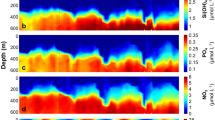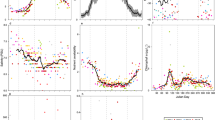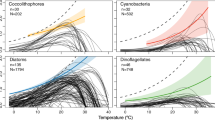Abstract
It is well established that there are distinct seasonal cycles in the production of plankton, that vary both geographically and in terms of phytoplankton-zooplankton coupling1 . Only recently have attempts been made to measure seasonal variability in the flux of various biogenic components from the ocean surface to the sea-floor2–4 and to relate this flux to local hydrographic conditions5. For example, a simple inverse relationship has been found between sediment flux to the seafloor and sea-surface temperature in the Sargasso Sea5. A three-year sediment trapping project in the subpolar North Pacific has allowed us to document both seasonal and interannual variability in the flux of planktonic foraminifera from the sea surface. We propose a model, based on the temperature preferences of planktonic foraminiferal species, the thermal structure of the upper water column and food availability, to explain the observed changes over time in foraminiferal production and flux.
This is a preview of subscription content, access via your institution
Access options
Subscribe to this journal
Receive 51 print issues and online access
$199.00 per year
only $3.90 per issue
Buy this article
- Purchase on Springer Link
- Instant access to full article PDF
Prices may be subject to local taxes which are calculated during checkout
Similar content being viewed by others
References
1. Heinrich, A. K. J. Cons. perm. int. Explor. Mer. 27, 15–24 (1962). 2. Deuser, W. G. & Ross, E. H. Nature 283, 364–365 (1980). 3. Honjo, S. Global Ocean Flux Study, 305–324 (National Academy of Sciences, Washington, DC, 1984). 4. Honjo, S. Science 218, 883–884 (1982). 5. Deuser, W. G. Deep Sea Res. 33, 225–246 (1986). 6. Honjo, S. & Wong, C. S. EOS 66, 1282 (1985). 7. Livingston, D. & Royer, T. C. J. phys. Oceanogr. 10, 753–764 (1980). 8. Royer, T. C. & Xiong, Q. Trap. Ocean–Atmos. Newsl. 24, 4–5 (1984). 9. Reed, R. K. Mar. Fish. Rev. 46, 7–12 (1984). 10. Miller, C. B., Frost, B. W., Batchelder, H. P., demons, M. J. & Conway, R. E. Prog. Oceanogr. 13, 201–243 (1984). 11. Anderson, G., Lam, R., Booth, B. & Glass, J. Spec. Rep. Dep. Oceanogr. Univ. Wash. 76, 1–231 (1977). 12. Frost, B. W., Landry, M. R. & Hassett, R. P. Deep Sea Res. 30, 1–13 (1983). 13. Stephens, K. Fish. Res. Board Can. Manuscr. Rep. Ser. 257(1968). 14. Frost, B. W. Global Ocean Flux Study, 125–135 (National Academy of Sciences, Washington DC, 1984). 15. Fulton, J. D. Can. Date Rep. Fish. Aquat. Sci. 374, 1–65 (1983). 16. Be, A. W. H. Oceanic Micropaleontology Vol. 1 (ed. Ramsay, A.) 1–100 (Academic Press, 1977). 17. Fairbanks, R. G. & Wiebe, P. H. Science 209, 1524–1526 (1980). 18. Fairbanks, R. G., Sverdlove, M., Free, R., Wiebe, P. H. & Be, A. W. H. Nature 298, 841–844 (1982). 19. Be, A. W. H. in Foraminifera: Notes for a Short Course Vol. 6 (ed. Broadhead, T. W.) 51–92 (Univ. Tennessee, 1982). 20. Hemleben, C. & Spindler, M. Utrecht Micropaleont. Bull. 30, 141–171 (1983). 21. Reynolds, L. & Thunell, R. C. J. for am. Res. 15, 282–301 (1985). 22. Honjo, S. & Doherty, K. W. Deep Sea Res. (in the press).
Author information
Authors and Affiliations
Rights and permissions
About this article
Cite this article
Thunell, R., Honjo, S. Seasonal and interannual changes in planktonic foraminiferal production in the North Pacific. Nature 328, 335–337 (1987). https://doi.org/10.1038/328335a0
Received:
Accepted:
Issue Date:
DOI: https://doi.org/10.1038/328335a0
This article is cited by
-
Pelagic calcium carbonate production and shallow dissolution in the North Pacific Ocean
Nature Communications (2023)
-
The daily resolved temperature dependence and structure of planktonic foraminifera blooms
Scientific Reports (2020)
Comments
By submitting a comment you agree to abide by our Terms and Community Guidelines. If you find something abusive or that does not comply with our terms or guidelines please flag it as inappropriate.



